How is your presidential knowledge? For example, can you guess:
- Which president used the most hand gestures?
- Which president smiled the most? The least?
- Which party uses more negative language?
In our human behavior research lab we analyzed these and other traits in the last 20 presidential inaugural addresses, Truman through Trump. Were there differences in body language, verbal patterns and persuasiveness in each inauguration speech?
The answers might surprise you.
#1: Which president used the most hand gestures in his inaugural address?
- a. John F. Kennedy
- b. Ronald Reagan
- c. Harry S. Truman
- d. Donald Trump
Hand gestures are an important mark of charisma for political candidates. We recorded both the number of hand gestures as well as the specific gestures themselves. Presidents most frequently use the thumbs-up gesture, pointing and open palm gestures. The president who used the most? That would be …
The correct answer: D. Donald Trump used the most hand gestures—641 in just 17 minutes! Ronald Reagan and Jimmy Carter relied too heavily on their podium and used none.
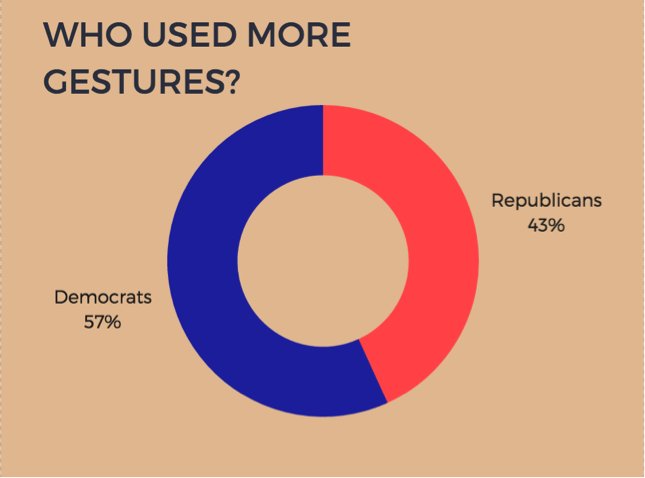
- Overall Democrats are more animated than Republicans.
#2: Which president smiled the most in his inaugural address?
- a. George H.W. Bush
- b. Barack Obama
- c. Richard Nixon
- d. Jimmy Carter
Smiling can be a signal of optimism, warmth and openness. Which president smiled the most? And which is the happier party? Based on smiles, here’s what we found:
- The correct answer: B. Barack Obama (second term). George H.W. Bush was a close second!
- What’s interesting is every president smiled more in their second term inaugural address than their first—maybe they get more relaxed the second time around.
- John F. Kennedy and Harry S. Truman smiled the least.
- Republicans smiled more—but not by much!
#3: Which president had the longest inaugural address?
- a. Jimmy Carter
- b. Dwight D. Eisenhower
- c. Harry S. Truman
- d. George W. Bush
Who spoke the longest? That would be…
The correct answer is C. Harry S. Truman at 22 minutes. George W. Bush (second term) came in a close second at 21 minutes.
The shortest of the last 20 presidential inaugural addresses belonged to Gerald Ford at eight minutes.
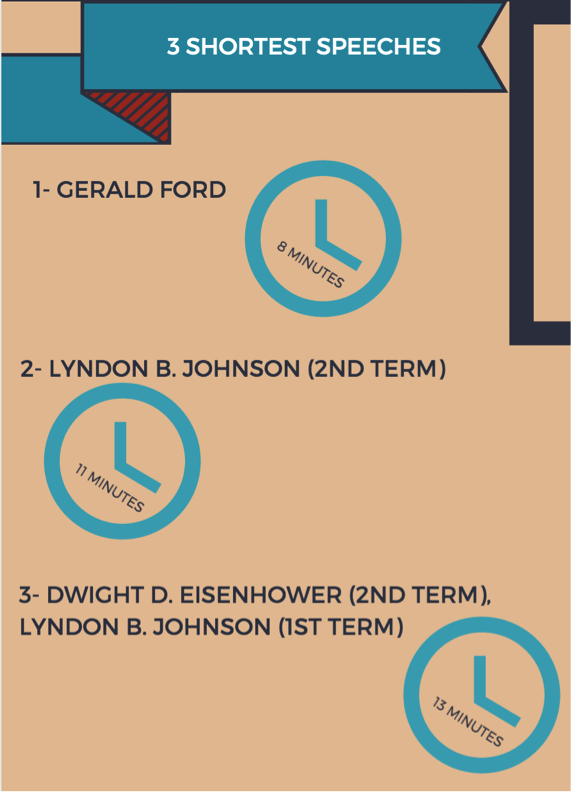
Republicans are the more verbose party—Republican presidents spoke far longer than Democratic ones.
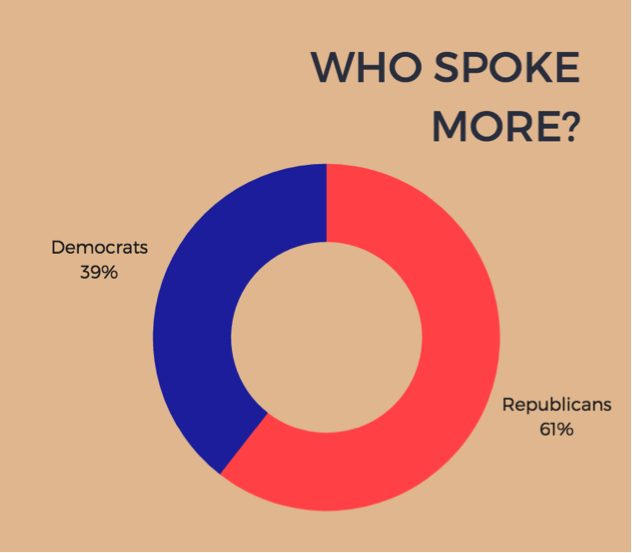
#4: Which tie color is the most popular in inaugural addresses?
- a. Red
- b. Blue
- c. Gray
- d. A tie between red and blue (A tie…Get it?)
We were curious about tie color, shirt color and suit color. The shirt color data was a dud—every president in this sample wore a white shirt. Which tie color is the most popular? Here’s the breakdown:
The most popular tie color is B. Blue, followed closely by red and a gray/blue mix.
- BOTH Republicans and Democrats wore blue and red—looks like their party’s logo color wasn’t a factor.
- Every president wore a black suit except one…Dwight D. Eisenhower:
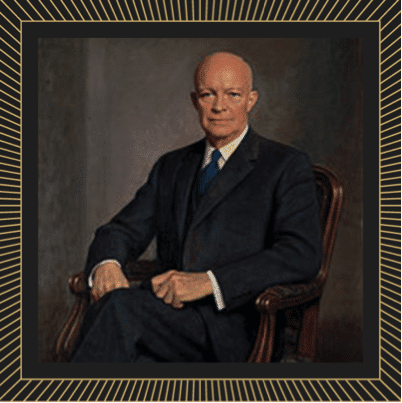
#5: Which president had the worst weather during his inaugural address?
- a. Ronald Reagan
- b. Gerald Ford
- c. Donald Trump
- d. John F. Kennedy
We were curious about who had the best and worst weather days. Who had bad luck?
The correct answer: A. Ronald Reagan had the worst weather during his inaugural address–a balmy 7.2 degrees! John F. Kennedy and Barack Obama (First Term) also had chilly speeches!
#6: Which president used the most pride poses in his inaugural address?
- a. Bill Clinton
- b. Barack Obama
- c. Donald Trump
- d. Lyndon B. Johnson
Researchers from the University of British Columbia[i] found that winning athletes use broad, expansive gestures. We coded presidential candidates on their alpha body language – or expansive gestures. Which president posed the most?
The correct answer: C. Donald Trump showed pride 20 times.
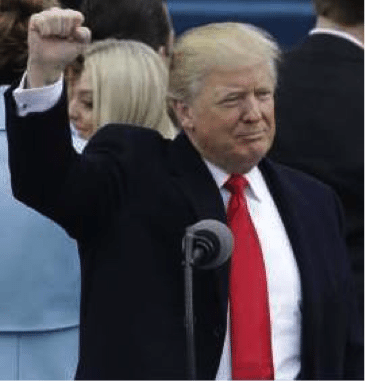
Barack Obama (Second Term) Showed pride 8 times.
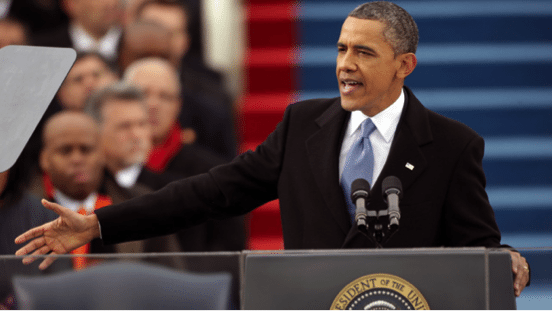
Bill Clinton (First Term) Showed pride 4 times.
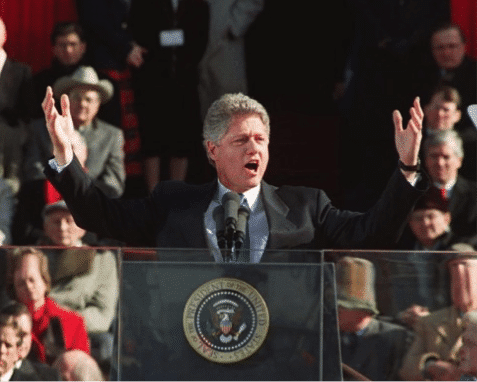
Overall Republicans use slightly more pride gestures than Democrats.
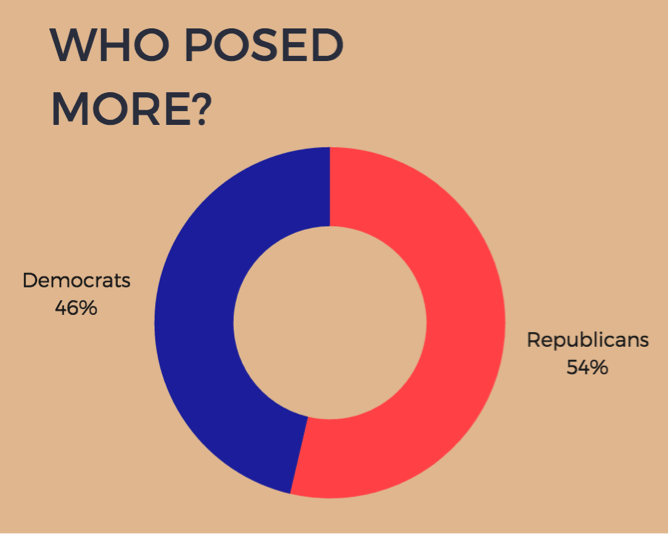
Psychologists[i] also have surveyed 846 academic historians and found that achievement-striving presidents do best in office. “Achievement-striving means people have high goals, but more importantly, they work hard to achieve them,” said the study author. “They stay focused; they are kind of workaholics.”[ii] In other words, we like presidents who strive to be winners. Pride posing can be an indication of an achievement-striving president.”
#7: Which president used the most emotional language in his inaugural address?
- a. Lyndon B. Johnson
- b. Richard Nixon
- c. Donald Trump
- d. George W. Bush
Emotionally charged language, imagery and metaphors activate audiences’ emotions to help them feel personally invested in the message. The president who used the most? That would be…
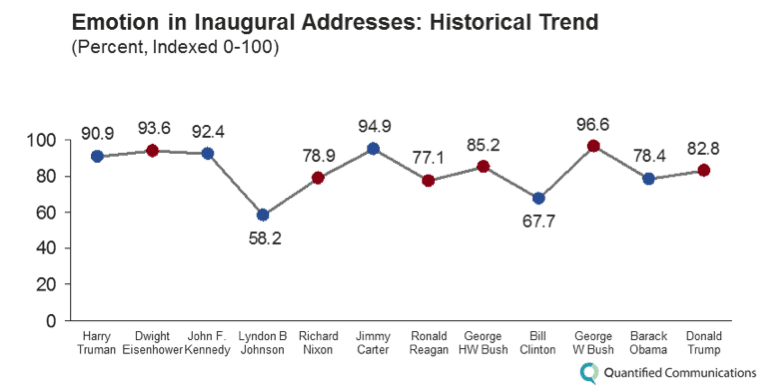
The correct answer is D. George W. Bush used the most emotion in his inaugural address, while President Johnson used the least.
Republican presidents used 9.5% more emotion than Democratic presidents during their inaugural addresses.
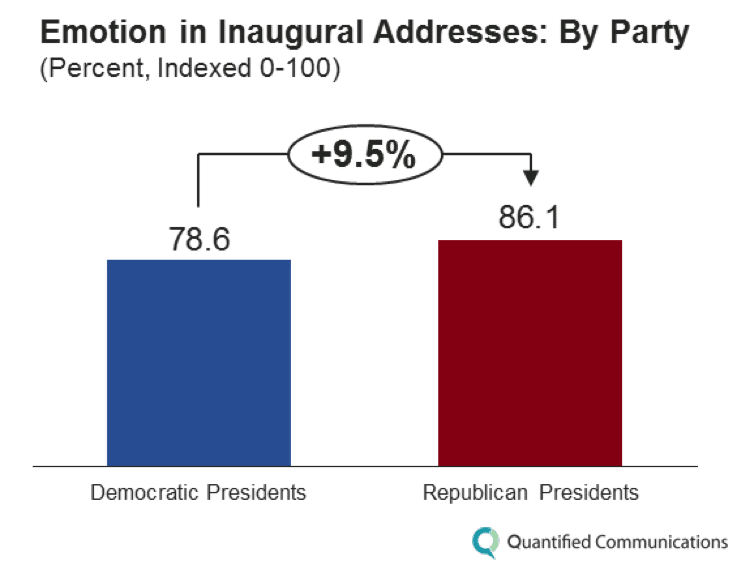
Here is a great example of emotional language from George W. Bush:
By our efforts we have lit a fire as well; a fire in the minds of men. It warms those who feel its power. It burns those who fight its progress. And one day this untamed fire of freedom will reach the darkest corners of our world.
George W. Bush, 2nd Inaugural Address, 2005
#8: Which president used the most logic in his inaugural address?
- a. Harry S. Truman
- b. John F. Kennedy
- c. Jimmy Carter
- d. George H.W. Bush
Some presidents appeal to logic more than others. Speaking with logic is when a president uses language establishing research and proof or cites data and statistics to support their arguments. The president who used the most logic? That would be…
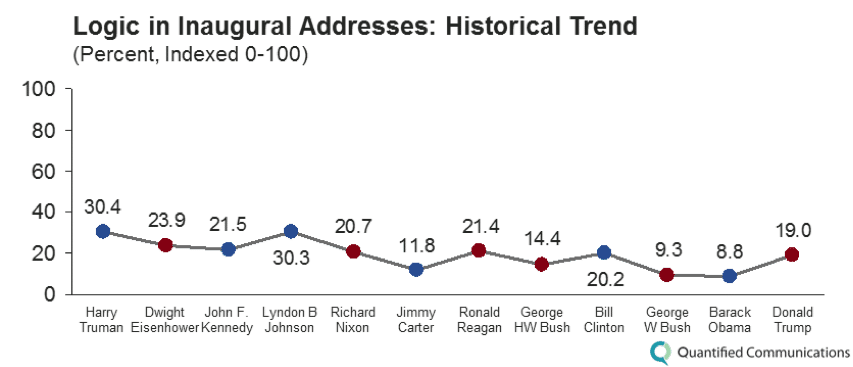
The correct answer is A. President Harry S. Truman used the most logic in his inaugural address, while President Barack Obama used the least.
Republican presidents used 3.2% less logic than Democratic presidents during their inaugural addresses.
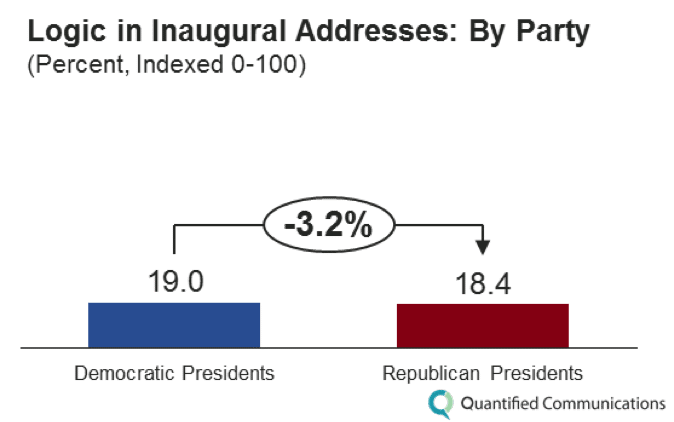
A great example of using of logic is from Harry S. Truman:
We are ready to undertake new projects to strengthen a free world. In the coming years, our program for peace and freedom will emphasize four major courses of action. […] On the basis of these four major courses of action we hope to help create the conditions that will lead eventually to personal freedom and happiness for all mankind.
Harry Truman, Inaugural Address, 1949
#9: Which president used the most negative language in his inaugural address?
- a. Donald Trump
- b. John F. Kennedy
- c. Barack Obama
- d. George H.W. Bush
The use of negative or positive language in an inaugural address can indicate a president’s perspective. Which president used the most negative language? That would be…
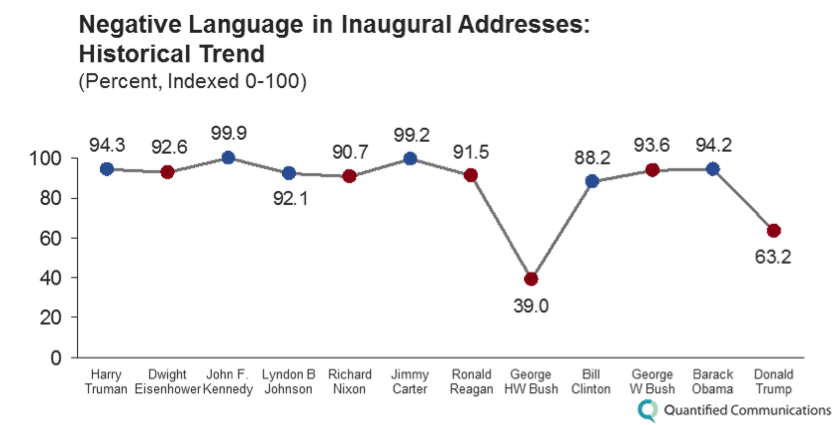
The correct answer is B. President John F. Kennedy used the most negative language in his inaugural address; President George H.W. Bush used the least.
President Eisenhower used the most positive language in his inaugural addresses; President Johnson used the least.
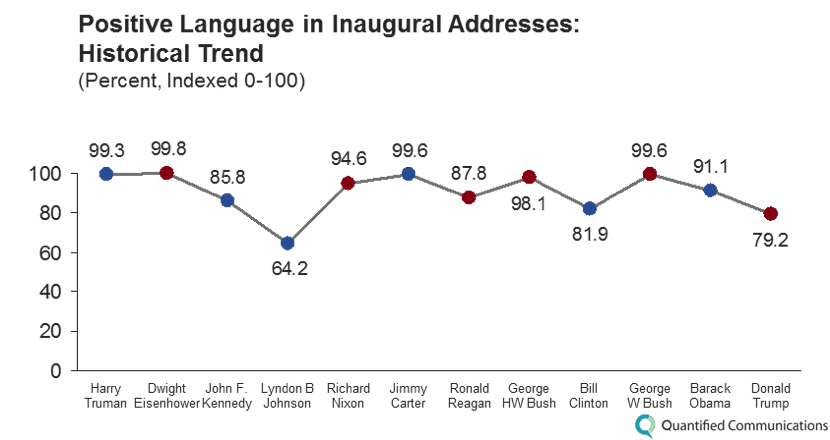
- Republican presidents used 10.6% less negative language than Democratic presidents during their inaugural addresses.
- Republican presidents ALSO used 8.4% more positive language. Looks as though the Democrats tend to sway more negative to neutral in their speeches.
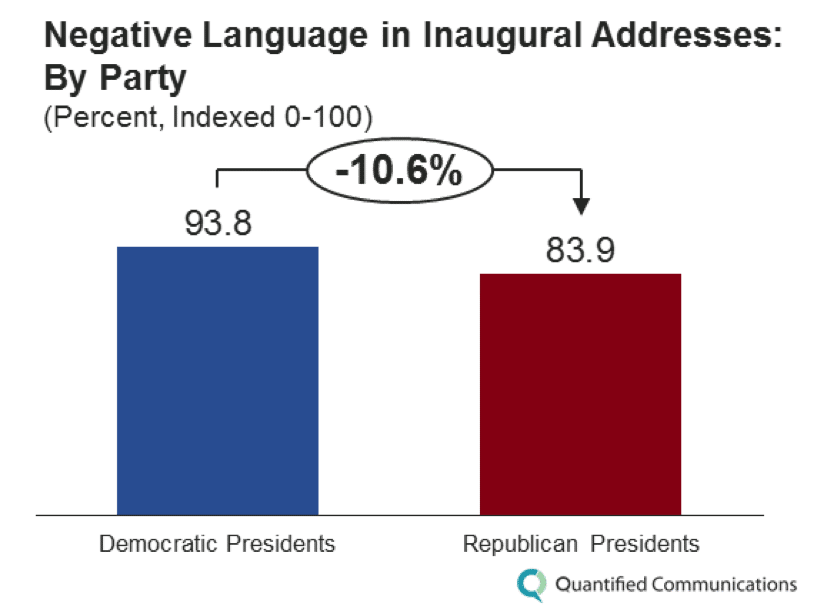
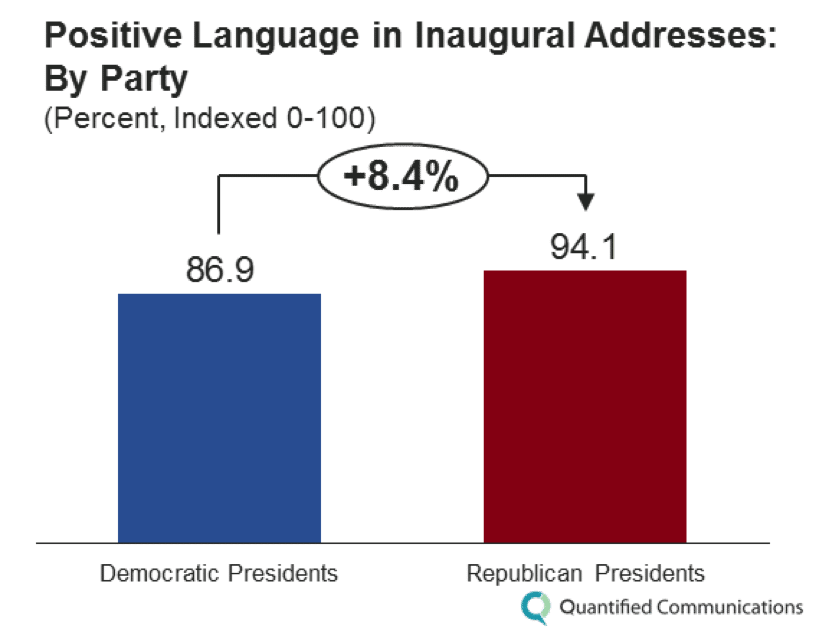
Here is an example of negative language use:
To those people in the huts and villages of half the globe struggling to break the bonds of mass misery…Finally, to those nations who would make themselves our adversary, we offer not a pledge but a request: that both sides begin anew the quest for peace, before the dark powers of destruction unleashed by science engulf all humanity in planned or accidental self-destruction.
John F. Kennedy, Inaugural Address, 1961
Compared to a positive example:
In the light of this equality, we know that the virtues most cherished by free people — love of truth, pride of work, devotion to country — all are treasures equally precious in the lives of the most humble and of the most exalted. The men who mine coal and fire furnaces, and balance ledgers, and turn lathes, and pick cotton, and heal the sick and plant corn — all serve as proudly and as profitably for America as the statesmen who draft treaties and the legislators who enact laws.
Dwight Eisenhower, 1st Inaugural Address, 1953
We also found that all but one two-term president used more positive language in his second-term inaugural address – the same happened with increased smiling in second-term speeches.

Presidents definitely feel more optimistic going into their second term—at least that is how they come across.
#10: Which president used the most individualistic language (“I, me and my”) in his inaugural address?
- a. Barack Obama
- b. Bill Clinton
- c. Lyndon B. Johnson
- d. Richard Nixon
Which president used more I, me and my? That would be…
The correct answer is C. President Lyndon B. Johnson used the most “I” language in his inaugural addresses, while President Obama used the least.
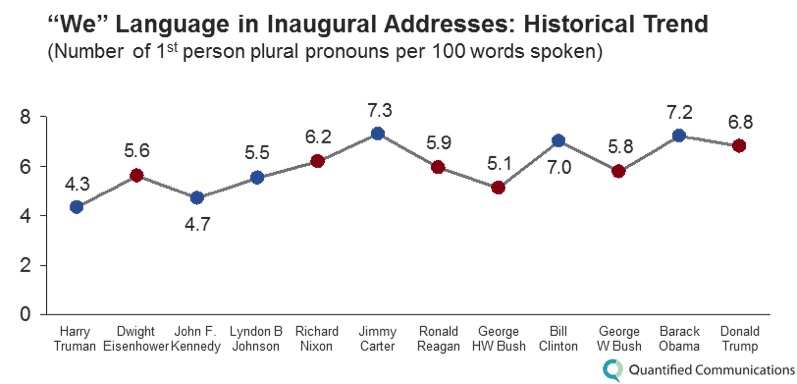
- President Jimmy Carter used the most “we” language in his inaugural address, while President Harry S. Truman used the least.
- Republican presidents used 18.0% more “I” language than Democratic presidents during their inaugural addresses.
- Republican presidents used 6.3% less “we” language than Democratic presidents during their inaugural addresses.
This again points to the idea that Republicans tend to emphasize the individual, where Democrats tend to focus on fostering more community.
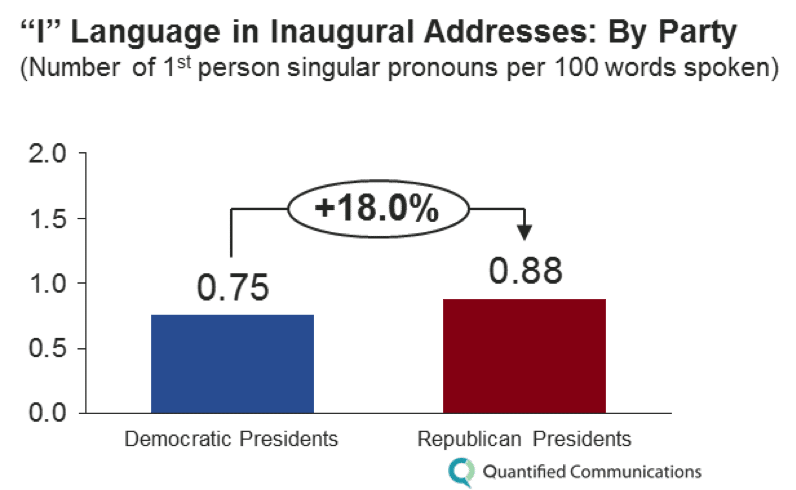
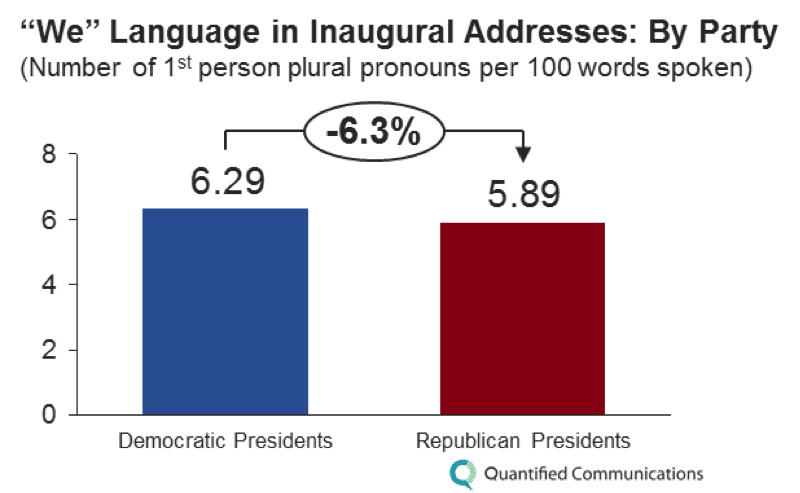
Here is an example of frequent personal pronoun use:
For the more than 30 years that I have served this nation, I have believed that this injustice to our people, this waste of our resources, was our real enemy. For 30 years or more, with the resources I have had, I have vigilantly fought against it. I have learned and I know that it will not surrender easily.
Lyndon B. Johnson, Inaugural Address,1965
And example of frequent third person pronoun use:
We cannot dwell upon remembered glory. We cannot afford to drift. We reject the prospect of failure or mediocrity or an inferior quality of life for any person. Our Government must at the same time be both competent and compassionate. We have already found a high degree of personal liberty, and we are now struggling to enhance equality of opportunity. Our commitment to human rights must be absolute, our laws fair, our national beauty preserved.
-immy Carter, Inaugural Address, 1977
#11: Which president used the most storytelling language in his inaugural address?
- a. Donald Trump
- b. Jimmy Carter
- c. Lyndon B. Johnson
- d. George W. Bush
Storytelling can be a very persuasive way of speaking, which appeals to a broader audience than just using logic or data. It is also a more emotional appeal to listeners than statistics alone. How did the presidents compare?
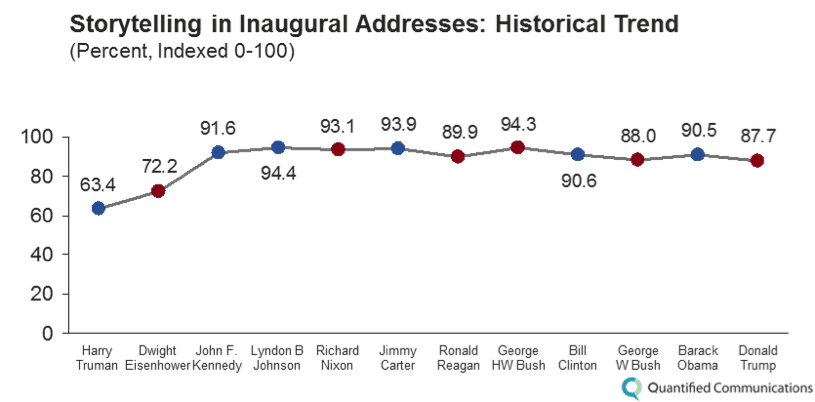
- The correct answer is C. President Lyndon B. Johnson used the most storytelling language in his inaugural addresses, while President Harry S. Truman used the least.
- Remember, Harry S. Truman also used the most logic—data and statistics. Clearly, he did this in lieu of stories.
- Republican presidents use only 1.5% less storytelling language than Democratic presidents during their inaugural addresses.
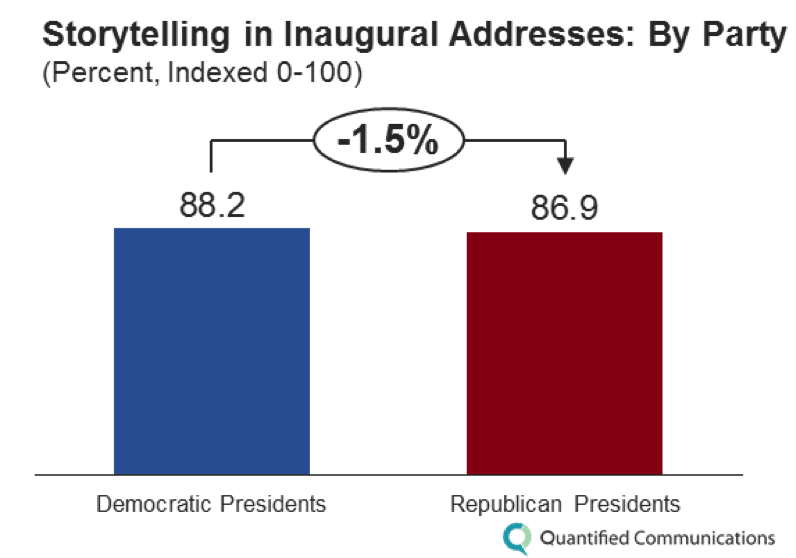
A storytelling example:
For every generation there is a destiny. For some, history decides. For this generation the choice must be our own. Even now, a rocket moves toward Mars. It reminds us that the world will not be the same for our children, or even for ourselves in a short span of years. The next man to stand here will look out on a scene that is different from our own.
Lyndon B. Johnson, Inaugural Address, 1965
#12: Which president used the most trustworthy language in his inaugural address?
- a. Dwight D. Eisenhower
- b. Jimmy Carter
- c. Harry S. Truman
- d. Ronald Reagan
Quantified Communications defines trustworthy language as “The linguistic patterns in a speech or written document that are proven to inspire audiences to trust the communicator.” They have found that these language patterns that can help speakers gain trust include insights behind stated goals, directness of language, demonstrated accountability, and a balanced emotional tone. Which president conveyed the most trust in his words? That would be…
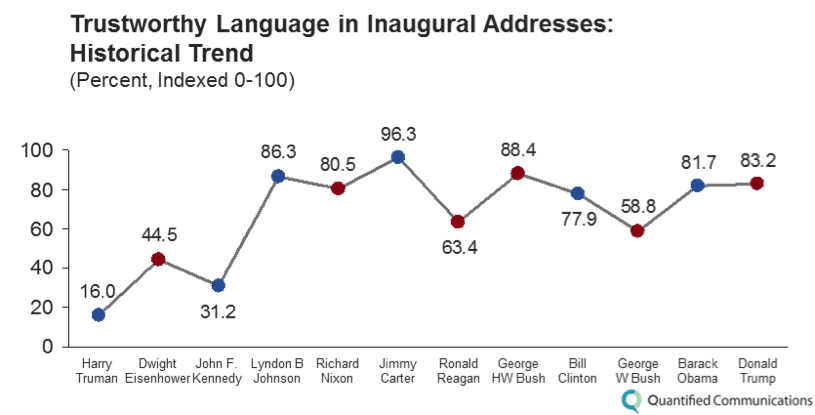
The correct answer is B. President Jimmy Carter used the most trustworthy language in his inaugural address, while President Harry S. Truman used the least.
Republican presidents used 3.0% less trustworthy language than Democratic presidents during their inaugural addresses.
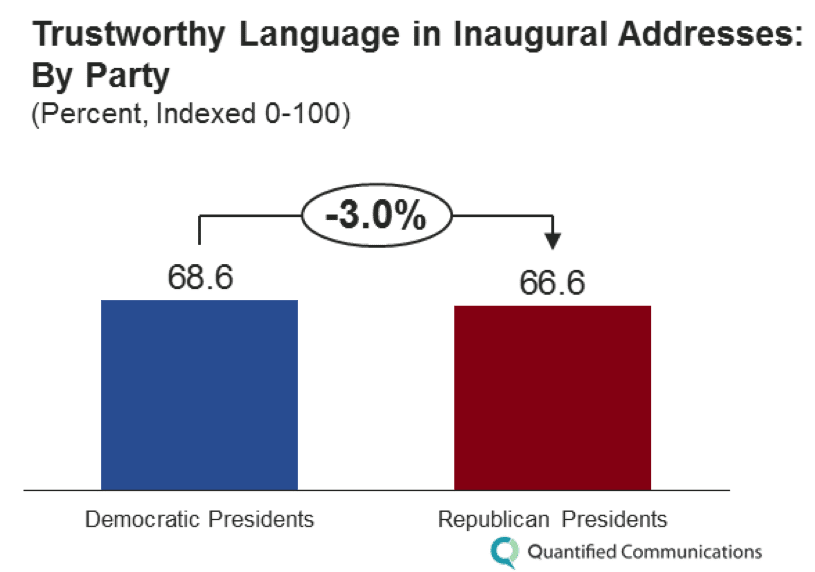
An example of trustworthy language:
I have no new dream to set forth today, but rather urge a fresh faith in the old dream. […] You have given me a great responsibility — to stay close to you, to be worthy of you, and to exemplify what you are. Let us create together a new national spirit of unity and trust. Your strength can compensate for my weakness, and your wisdom can help to minimize my mistakes.
Jimmy Carter, Inaugural Address, 1977
#13: Which president had the most clarity in his inaugural address?
- a. George H.W. Bush
- b. Richard Nixon
- c. Barack Obama
- d. John F. Kennedy
The correct answer: A. President George H.W. Bush used the clearest language in his inaugural address, while President Harry S. Truman used the least.
Republican presidents use 9.2% clearer language than Democratic presidents during their inaugural addresses.
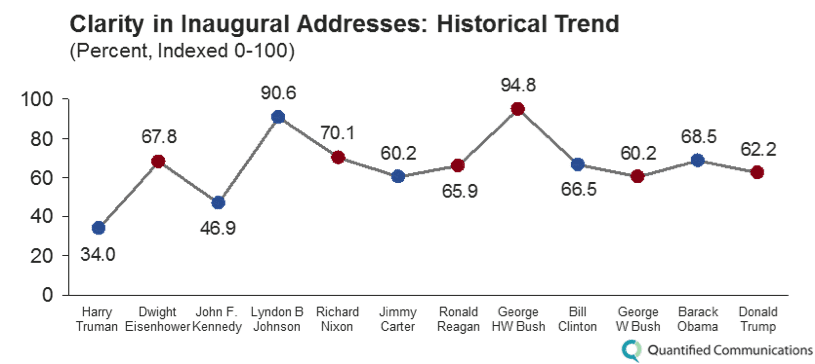
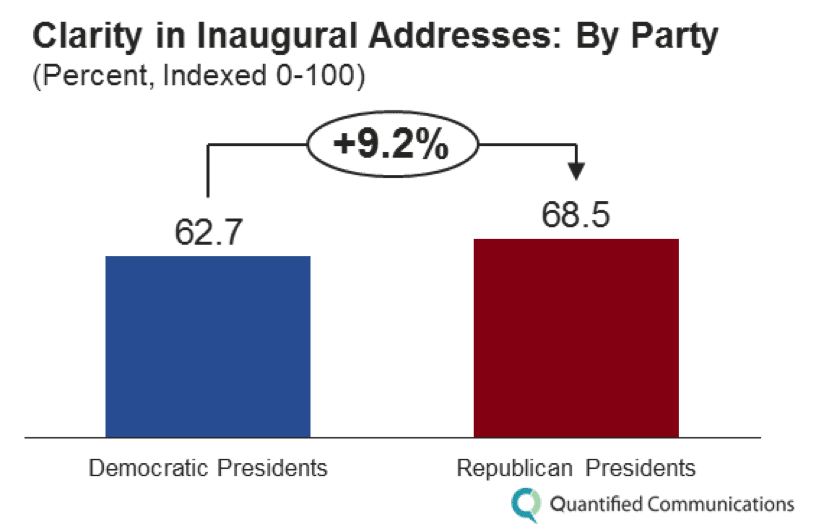
An example of clear language comes from President George H.W. Bush:
We know what works: Freedom works. We know what’s right: Freedom is right. We know how to secure a more just and prosperous life for man on Earth: through free markets, free speech, free elections, and the exercise of free will unhampered by the state.
George H.W. Bush, Inaugural Address, 1989
Summary:
It is clear both parties have patterns. Republicans tend to use more emotional language, more stories and intense words (both positive and negative). Democrats love data and logic. They are more likely to use neutral language.
Our presidents who used nonverbal communication the most also have been our more recent ones–Donald Trump and Barack Obama smiled and used the most hand gestures.
Some findings surprised us, especially which presidents used more data and negative language. Many viewers believed Donald Trump’s inaugural address was one of the most negative we have heard in recent years. And here is where there is a special wrinkle in the data. Use of negative language was measured by frequency, not degree. Trump might have had less negative language overall, but when he was negative, he did not hold back.
What We Coded:
We examined the verbal and nonverbal patterns of all 20 presidential inaugural addresses given since Harry Truman’s in 1949.
- We compared 11 addresses given by Republican presidents and 9 addresses by Democratic presidents.
- The analysis also includes historical patterns. In the cases where a president gave a second inaugural address after being elected to a second term, the scores in each metric represent an average of that president’s two addresses.
Looking at 13 different metrics for each address, we found interesting nonverbal and verbal patterns. For the verbal metrics, we partnered with Quantified Communications to use their communication measurement platform to analyze the transcript of each speech.
Researchers:
Vanessa Van Edwards is a behavioral investigator and published author. She figures out the science of what makes people tick at her human behavior research lab, Science of People. As a geeky, modern-day Dale Carnegie, her innovative work has been featured on NPR, Business Week and CNN.
Quantified Communications is our analytics partner. The QC platform, built on years of scientific communication research, uses a combination of natural language processing, automated vocal analysis, and insights from a panel of Ph.D.-level communication experts to help the leaders across the globe measure and improve their communication. QC’s work has been featured on WSJ, Business Insider, Forbes, and the TED mainstage.
A Note on Quantified Communications’ Data: With the exception of the pronoun category, the research-validated algorithms used to score each metric are composed of several linguistic attributes proven to measure that particular element of communication effectiveness. QC uses natural language processing to measure each communication, then index the raw scores in each metric against millions of data points in their global communication database. The % scores in each metric reflect how that speaker performs compared to the average communicator in that database.
Citations:
- Greatness in the White House: Rating the Presidents, Washington through Carter,” (Pennsylvania State University Press, 1988).
- http://www.apa.org/monitor/nov04/presidential-personality.aspx
- http://news.ubc.ca/2008/08/11/ubc-study-of-olympic-athletes-shows-that-pride-and-shame-are-universal-expressions/
- http://www.apa.org/monitor/nov04/presidential-personality.aspx
- Bull, Peter. Body movement and interpersonal communication. John Wiley & Sons Inc., 1983.
- http://www.tandfonline.com/doi/abs/10.1080/08351810802028662
